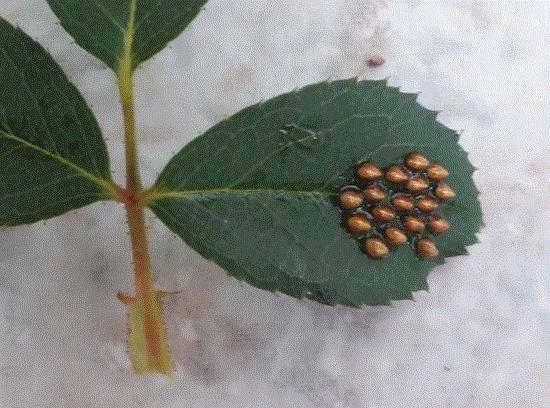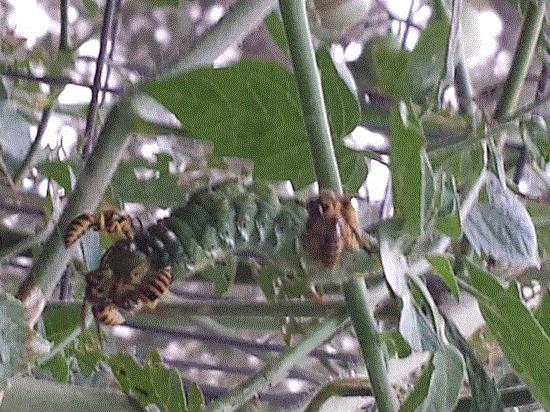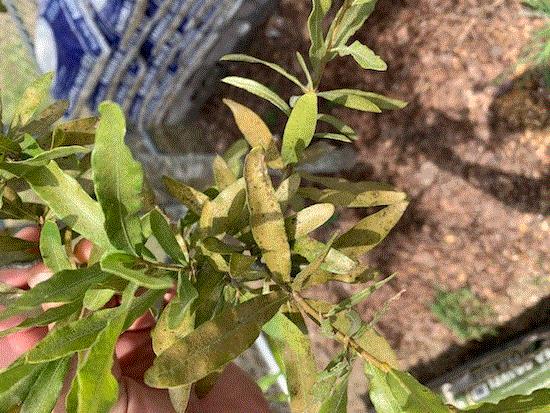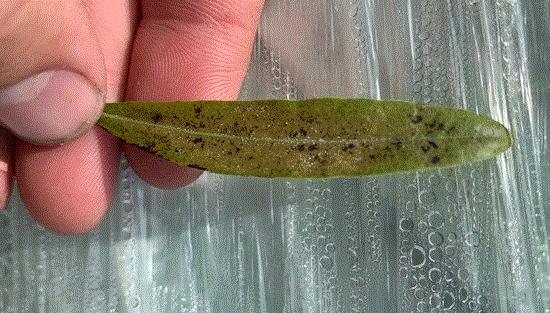What the ... ?, Take one
I didn't have quite enough space last week to show y’all a few “What the … ?” creatures that I’d collected over the past few weeks. I’ll share them this week.
The first one came from Patricia Cooke. She found some golden eggs on a rose leaf. The extension agent in Beaufort County, South Carolina, Laura Lee Rose, forwarded the picture to me, as Pat and Laura Lee wondered what those are.
The answer is … beats me. My guess is eggs of a leaffooted bug (but not those of Leptoglossus, a common group that I find on my tomatoes and okra) or a squash bug. Probably, a bug wandered from the vegetable garden and found a rose bush that seemed great for putting down some eggs. Insects often deposit eggs on plant species that may not serve as their normal host, for reasons I cannot fathom.

Photo credit: Patricia Cooke.
The next one is very cool. Not much of a mystery, but it’s something I have never seen before (which doesn't really say much …) Diane Morey of Hilton Head Island, South Carolina, sent a picture of a few “parasitoids” or “small bees” attacking a tomato hornworm to Laura Lee, whom in turn forwarded it to me. It turned out that the “small bees” were actually yellow jackets. Diane also made the observation that these yellow jackets were not aggressive at all. I guess when they were occupied with tearing a hornworm into pieces, the yellow jackets didn’t see a human as a threat.

Photo credit: Diane Morey

What the ... ?, Take two
Caleb Badgett, a recent Clemson University graduate and now a proud employee of his family’s feed and seed store and nursery, sent my colleague Bob Polomski a series of pictures. Several willow oaks were planted in the parking lot of the store. Remembering what Bob taught him in the Landscape Plants course (kudos to Bob and Caleb), Caleb did the site preparation properly and provided the trees with plenty of room to grow. The oak trees are doing well, but there are some issues that turned leaves chlorotic and spotted. Caleb wondered what happened, and Bob suggested that spider mites might be to blame.

Photo credit: Caleb Badgett
Bob was spot-on! The oak spider mite (a.k.a. red oak mite), Oligonychus bicolor, damaged the leaves. Now, don't you go Google “red oak mite” and freak out by the first few hits that tell you they’ll cause serious itching and swelling. The oak spider mite ain’t the same as oak tree itch mite, itch mite or oak leaf gall mite. The oak spider mite is a, well, spider mite. It only feeds on leaves and has no interest in human flesh.
Y’all can see the stippling and whitish shed skins on the leaves. The oak spider mite is a very common spider mite species and feeds on just about any oak species. I’ve seen them on oak trees planted in the urban landscape year after year; perhaps the dry and hot conditions in the cities (and particularly around paved surfaces) promote spider mite population growth. Although infestation can cause the entire tree to turn bronze or chlorotic, I usually don't detect any noticeable reduction in tree vigor.


Photo credit: Caleb Badgett
Caleb wondered what he could do. He had tried a systemic insecticide application but that didn't work. There is no surprise there because through pioneering work done by Mike Raupp (University of Maryland) and his student Ada Szczepaniec (now at Texas A&M University), we now know that neonicotinoids can cause more spider mite problems. I’m not going into the causes of why neonicotinoids may cause spider mite outbreaks today; that’s a whole monologue on its own. Quote my teenage son new to the minefield of puppy love, “It’s complicated.”
Not much is known about the oak spider mite. This species overwinters as eggs on the nooks and crannies of bark. The eggs hatch in the spring, and the mite population builds up over several generations until damage becomes noticeable in the summer. Just before leaf drop, female mites move to the bark and deposit overwintering eggs, and the cycle continues.
I cannot find much research on how to control the oak spider mite, but several approaches have been suggested. Keeping trees irrigated to reduce stress may help, but do not fertilize because fertilization seems to promote mite population growth in general. You can spray dormant oil on the trunks and branches of infested trees in the winter or early spring (before bud break). For most homeowners, insecticidal soap and horticultural oil are just about the only options. For the professionals, there are more miticide options. Miticides registered for landscape use include abamectin (Avid, IRAC Group 6), acequinocyl (Shuttle, 20B), bifenazate (Floramite, 20D), cyflumetofen (Sultan, 25), etoxazole (TetraSan, 10B), fenazaquin (Magus, 21A), hexythiazox (Hexygon, 10A) and spiromesifen (Savate, 23).
I discourage y’all from using broad-spectrum insecticides, such as organophosphates, carbamates, pyrethroids and neonicotinoids, because they are usually not super effective against spider mites. They do a better job of killing natural enemies of the spider mites, which in turn causes an outbreak of the mite population.
By the way, the damage to the leaves is permanent. So the damaged trees will look awful for the rest of the summer. You’ll have to wait for new leaves to flush next spring, and catch the next mite generation before it becomes damaging.

PerCarb fungicide now available in California
BioSafe Systems’ PerCarb bactericide/fungicide has been approved for use in California. PerCarb contains 85% sodium carbonate peroxyhydrate. This active ingredient has been used extensively for algae control in ponds and water bodies, in products such as GreenClean and PAK 27. Sodium carbonate peroxyhydrate is made by combining sodium carbonate and hydrogen peroxide. When mixed in water, the compound breaks down into hydrogen peroxide and sodium carbonate again. It is hydrogen peroxide that does the killing, working in the same way as other hydrogen peroxide fungicides, such as ZeroTol. There is lots of fungicidal efficacy data on hydrogen peroxide, so I won't be doing a deep dive here.

California registration of PerCarb allows its use on carrots, cucurbits, grapes, leafy greens and strawberries for powdery mildew, on fruiting vegetables for bacterial leaf spot, and on pome fruit for scab. BioSafe Systems lists greenhouse fruits and vegetables as use sites.
PerCarb can be applied as a foliar spray with no phytotoxicity, and as early and late dormant spray. The use rate ranges from 0.25 to 1 lb. of product for every 25 gallons of water. For enclosed greenhouses, the restricted entry interval (REI) is one hour for spraying and fogging. The REI for non-spraying or fogging applications, such as pre-plant dip, seed treatment, soil drench, mop and rinse is zero hours.
Click here for a copy of the California label.

AXXE herbicide now available in Canada
BioSafe Systems also announced that its AXXE herbicide is now available in Canada. AXXE is a herbicidal soap, containing 36% ammonium salts of fatty acids. AXXE is a broad-spectrum, burn-down herbicide for grass and broadleaf weeds. Registered use sites in Canada include ornamentals and turf in landscapes, interiorscapes, greenhouses and non-crop areas on farms.

AXXE should be applied at 5% concentration. Similar to many burn-down herbicides, AXXE is most effective when used against young weeds or new growth. The target weeds must be thoroughly covered with the spray solution. It doesn’t have residual activity, therefore reapplication may be needed in some situations.
Click here for a copy of the Canadian label.
See y'all next time!

JC Chong
Professor of Entomology at Clemson University
This e-mail received by 25,257 subscribers like you!
If you're interested in advertising on PestTalks contact Kim Brown ASAP!